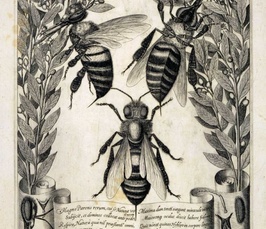Visual and Material Culture of Microscopy in Seventeenth-Century Italy
Workshop
- Participation on site previous registration
- Beginn: 22.06.2022
- Ende: 24.06.2022

This international workshop takes as a starting point the drawings and
printed images that were created by seventeenth-century microscopists and their
artists. In a conversation between experts on seventeenth-century lenses (in
microscopes and telescopes), early modern scientific instruments, epistemic
images before and after the introduction of the microscope, the Italian
microscopic networks, and drawing as an observational art, this workshop aims
at understanding better the visual strategies of depicting the previously
unseen and unknown. How did one communicate something to scientific colleagues
and a wider audience that has never been seen before? How did the first Italian
microscopists visualize their observations and what kind of visual traditions
did they choose to use? How did these earliest representations influence later
visual depictions of microscopic observations? Did the early microscope dictate
a specific observation regime, and how did that affect microscope and visualization
practice? And how was it that Italy with its famous instrument makers,
scientific practitioners, and visual artists stood at the start and center of
an European-wide network of microscopic research throughout the seventeenth
century?
PROGRAM
Visual and Material Culture of Microscopy in Seventeenth-Century Italy
Workshop at the Bibliotheca Hertziana – Max Planck Institute for Art History
Organized by Sietske Fransen (BHMPI) and Tiemen Cocquyt (Rijkmuseum Boerhaave).
BIBLIOTHECA HERTZIANA, Via Gregoriana 22, Villino Stroganoff
13:30 Doors open for coffee
14:00-14:45 Welcome by Tiemen Cocquyt (Rijksmuseum Boerhaave) and Sietske Fransen (BHMPI)
14:45-15:30: Luca Tonetti (Università di Bologna): Insect anatomy unveiled: A first look at Marcello Malpighi's unpublished notes
15:30-16:00 coffee break
16:00-18:00 Marvin Bolt (Technische Universität Berlin/Corning Museum of Glass) and Michael Korey (Staatliche Kunstsammlungen Dresden): Brotherly Love: Telescopes and Microscopes
18:30 Dinner provided by Rijksmuseum Boerhaave in Villino Gardens (Bibliotheca Hertziana) for all speakers, invited guests, and Research Group
Thursday 23 June
Train from Rome Termini to Florence (7:25am)
Meeting point at 7:00am in front of the station close to the taxi stand (Piazza del Cinquecento).
10:00-12:00 Visit to Casa Buonarroti
Presentation by Cammy Brothers (Northeastern University, Boston): Observing Michelangelo
Tour along original Michelangelo drawings
12:00-13:00 lunch (individually)
13:00-14:00 Visit to Basilica San Lorenzo (grave of Nicholas Steno and small exhibition from La Specola, Natural History Museum).
14:30-16:30 Visit with guided tour at Museo Galileo.
Train back from Florence to Rome (around 18:03).
Meeting point 17:45 inside the station in front of gates towards the platforms.
Friday 24 June
9:15-10:00 Tour of the Bibliotheca Hertziana (meet in front of the main entrance)
10:00-11:00 Rare book session with early printed books from the Hertziana collections
11:00-11:30 Coffee Break
Session Chair: Ellen Pater (Huygens Institute/Leiden University)
11:30-12:15: Eric Jorink (Huygens Institute/Leiden University): The Microscope made Uneasy: Some thoughts on Humanists, Protestants, and the smallest letters in the Book of Nature, ca. 1560-1640
12:15-13:00: Pamela Mackenzie (KHI Florenz, A4Lab Berlin): Eggs, Seeds and Apricots: Microscopic Evidence in Seventeenth-Century Generation Debates
13:00-14:00 Lunch provided at Bibliotheca Hertziana
Session Chair: Eric Jorink (Huygens Institute/Leiden University)
14:00-14:45 Francesco Barreca (Università Statale di Milano): Instruments, Experimentation, and Narrative Building in the Saggi di Naturali Esperienze: a preliminary quantitative analysis
14:45-15:30 Christoph Lüthy (Radboud University Nijmegen): How Slowly the Microscope Became an Instrument!
15:30-16:00 Coffee Break
Session Chair: Tim Huisman (Rijksmuseum Boerhaave)
16:00-16:45 Wim van Egmond (microphotographer): Portraying Microbes
16:45-17:30 Final Remarks (Tiemen Cocquyt & Sietske Fransen)
For participation register via email: boehm@biblhertz.it
Organized
by Sietske Fransen (BHMPI) and Tiemen Cocquyt (Rijkmuseum Boerhaave)
This workshop
is organized by the Max Planck Research Group Visualizing Science in Media
Revolutions in collaboration with Rijksmuseum Boerhaave as part of the
NWO-funded project Visualizing the Unknown.